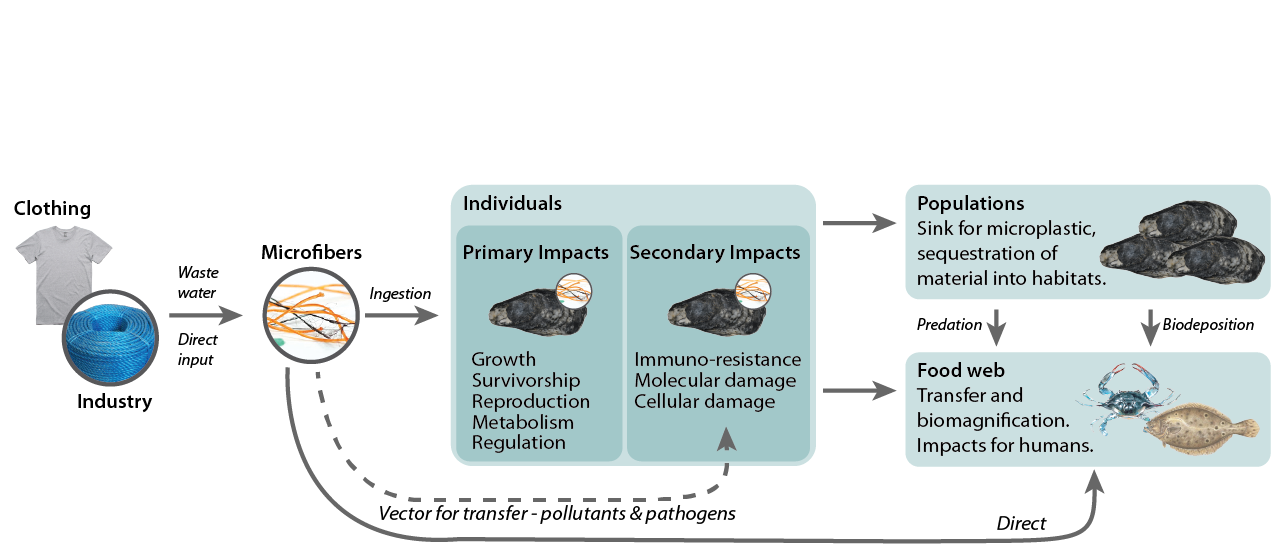Marine plastics

Diagram showing how microplastic fibers enter the marine environment, potential impacts and how they move through benthic species, into higher trophic levels.
About
In 2017 alone, roughly 348 million tons of plastics were produced worldwide, and global yearly production is expected to triple by 2050 (PlasticsEurope 2018). Plastics are light-weight, durable, inexpensive and easily modified, making their use in the modern economy ubiquitous (PlasticsEurope 2018). Unfortunately, these very same properties that make plastics so important also directly contribute to their prevalence in, and negative impacts on, the environment. Their light-weight allows them be transported significant distances from their sources, their durability allows them to persist in the environment for a long time, and their low cost and easy production make them more likely to be discarded after a single use (Thompson 2015; Lusher et al. 2017). Additionally, the US recovers less than 10% of its annual plastic production (US EPA 2018). Nearly 85% of all marine debris is plastic and it has become the fastest growing component of municipal waste (Auta et al. 2017).
Microplastic particles (<5mm) can originate from industrial and domestic sources (i.e., primary microplastics, e.g. exfoliating facial scrubs, toothpastes, resin pellets, clothing and textiles) or be formed in situ from the breakdown of larger plastic items under ultraviolet radiation and mechanical abrasion (i.e. secondary microplastics). These plastics accumulate in the marine environment, resulting in over 5 trillion floating plastic particles in the surface waters of our oceans (Eriksen et al. 2014). As such, there is a major global effort to better understand the sources, transport, fate and impact of plastic pollution within the marine environment (GESAMP 2015).
Citations
Auta, H.S., Emenike, C.U., and Fauziah, S.H. (2017). Distribution and importance of microplastics in the marine environment: A review of the sources, fate, effects, and potential solutions. Environment International 102, 165–176.
Eriksen, M., Lebreton, L.C.M., Carson, H.S., Thiel, M., Moore, C.J., Borerro, J.C., Galgani, F., Ryan, P.G., and Reisser, J. (2014). Plastic Pollution in the World’s Oceans: More than 5 Trillion Plastic Pieces Weighing over 250,000 Tons Afloat at Sea. PLoS ONE 9, e111913.
GESAMP (Joint Group of Experts on the Scientific Aspects of Marine Environmental Protection), (2015). Sources, fate and effects of Microplastics in the Marine Environment: A Global Assessment. Retrieved on May 28, 2019 from http://www.gesamp.org/publications
Lusher, A.L., Welden, N.A., Sobral, P., and Cole, M. (2017). Sampling, isolating and identifying microplastics ingested by fish and invertebrates. Analytical Methods 9, 1346–1360.
PlasticsEurope. (2016). Plastics – the Facts 2016. (available at www.plasticseurope.org). Accessed November 30, 2018.
Thompson R.C. (2015). Microplastics in the Marine Environment: Sources, Consequences and Solutions. In Marine anthropogenic litter, M. Bergmann et al. (eds.), Cham Heidelberg New York Dordrecht London: Springer. DOI 10.1007/978-3-319-16510-3_7
US EPA. (2018). Advancing sustainable materials management: 2015 fact sheet. Washington DC, EPA530-F-18-004
